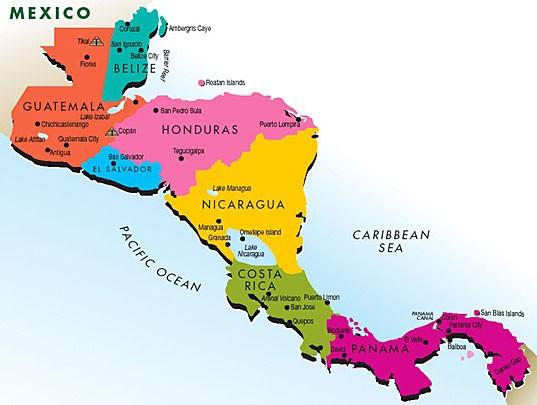Authored by Ryan McMaken via The Mises Institute,
Former Secretary of State George Schultz has an idea for dealing with increased immigration from the Northern Triangle region of Central America, which includes of El Salvador, Guatemala and Honduras: he wants to spend more money on foreign aid.
In yesterday’s Wall Street Journal, Schultz writes that the countries of the Northern Triangle could “increase the ‘supply’ of good governance by us[ing] foreign aid to fund better policing, transparency and higher-quality services—and apply international pressure to root out corruption and encourage political reform.”
And who could supply this foreign aid?
According top Schultz, “the U.S. is the only nation with the economic, technological and political authority to lead,” and “[t]he Inter-American Development Bank could do so by redirecting existing funds without new U.S. expenditures, and could get started with a phone call in Washington.”
Schultz wisely doesn’t mention any dollar amounts. How could he? His proposal is clearly meant to be a sort of trial balloon: demand more government spending now, and work out all the details in the back rooms later.
But we know how this sort of thing works.
There is no real expectation that foreign aid would actually remake the economies of the Northern Triangle.
In reality, it will be yet another foreign aid boondoggle: friends of the US regime will receive funds. There will be little follow-up as to how the money is spent. The money may even go to fund despots who will use the funds to murder their enemies. George Schultz’s personal friends and colleagues will no doubt get their cut. This is how the US foreign aid game is played.
It is interesting that Schultz doesn’t mention something that does have the potential for revolutionizing the region’s access to capital and its standard of living. It will do this while greatly lessening the incentive to emigrate from the region to the US: unrestricted trade with the United States.
To accomplish this, the US need not collect any new taxes. It need not impose any new regulations. It need not form any international “coalitions.”
Instead, it only has to make the Northern Triangle a true Free Trade Zone with full access to US markets.
At this point, some observers may claims “the US already has a free trade agreement with Central America! In fact, the region is largely duty free!” But this objection helps to illustrate just how much the term “free trade” has been corrupted in the phrase “free trade agreement.” In practice, only qualifying goodscan be imported to the US from Central America duty free. In order to qualify, goods must meet a variety of bureaucratic requirements stemming from “rule of origin” requirements. These rules exist to prevent “trade diversion” and other types of trade in which a Central American country might import parts from outside the free trade zone, add only small amounts of value, and then export the finished product to the US. Thus, trade between Central America and the US is not really free, and the trade agreements specifically prevent Central American countries from becoming trade and shipping centers where goods and services can be freely imported and exported globally.
If Central America had a true free trade agreement with the US, however, both US and foreign manufacturers would have an enormous incentive to set up shop in the region and produce goods there for the US market.
Over time, capital would flood into the region, greatly increasing the standard of living for Central Americans while providing new sources of goods and services for American entrepreneurs and consumers.
The success of such a plan, of course, is not guaranteed. The regimes of El Salvador, Guatemala, and Honduras could squander the opportunity. They could insist on high domestic taxes or an insecure legal environment in which private business owners would have reason to fear expropriation by the regime.
But when facing the possibility of true free trade with the US, the stakes would become very high indeed, and the regime could choose between guaranteed moderate levels of tax revenue, or the disastrous policies of expropriation.
But no matter how it turns out, the US taxpayer is not on the hook for anything. There is no risk of foreign aid flushed down the toilet. Instead, the upside is substantial: access to low-cost goods and services from American, Asian, and European firms all hungry to take advantage of this new “free trade zone” in the western hemisphere. American entrepreneurs would be able to provides goods and services at lower prices. They could hire more workers. They could invest more of their profits.
Moreover, the geo-political benefits would be substantial. The regimes of the Northern Triangle would become committed to maintaining friendly relations with the US, and the pressures of high levels of migration from the region would be lessened.
In his essay ” The Case for Free Trade and Restricted Immigration ,” Hans-Hermann Hoppe recognized the benefits of free trade in immigration policy:
The relationship between trade and migration is one of elastic substitutibility (rather than rigid exclusivity): the more (or less) you have of one, the less (or more) you need of the other . [Emphasis added.] Other things being equal, businesses move to low wage areas, and labor moves to high wage areas, thus effecting a tendency toward the equalization of wage rates (for the same kind of labor) as well as the optimal localization of capital. With political borders separating high- from low-wage areas, and with national (nation-wide) trade and immigration policies in effect, these normal tendencies—of immigration and capital export—are weakened with free trade and strengthened with protectionism. As long as Mexican products—the products of a low-wage area—can freely enter a high-wage area such as the U.S., the incentive for Mexican people to move to the U.S. is reduced. In contrast, if Mexican products are prevented from entering the American market, the attraction for Mexican workers to move to the U.S. is increased. Similarly, when U.S. producers are free to buy from and sell to Mexican producers and consumers, capital exports from the U.S. to Mexico will be reduced; however, when U.S. producers are prevented from doing so, the attraction of moving production from the U.S. to Mexico is increased.
Bizarrely, protectionists take the opposite self-defeating approach: they want to cut off trade with other nations, thus reducing the standard of living. This then increases the incentive for foreigners to emigrate to the United States. The protectionists then complain there’s too much immigration and the government must intervene even more to control both trade and migration.
Not surprisingly, Ludwig von Mises saw the ridiculouslness of this position. As I noted in my article ” If You Don’t Like Immigration, You Should Love Free Trade “:
Opponents and proponents of immigration may argue endlessly about the potential downsides and upsides of immigration. (For an especially nuanced and insightful view of the downsides, see Ludwig von Mises’s work on nationalism and immigration .)
With free trade, though, there is no downside, which is why Mises, who allowed for a number of caveats on immigration, made no exceptions for free trade.
For many modern protectionists, though, the desire to close off trade stems not just from economic ignorance, but from an emotional desire to actually harm other countries on nationalistic grounds. The economic implications of these policies then become secondary to other ideological agendas. Mises understood this well, and in Human Action concluded :
We may, for the sake of argument, disregard the fact that protectionism also hurts the interests of the nations which resort to it. But there can be no doubt that protectionism aims at damaging the interests of foreign peoples and really does damage them. … The philosophy of protectionism is a philosophy of war.
George Schultz is correct in the sense that a prosperous Central America is a Central America with less incentive to send its workers and families to North America. But the real solution does not lie in throwing a few extra bucks at the central American regimes in hope they might build a couple of new highways. The real solution lies in expansion of trade, capital investment, and . Only then can a sustainable solution to the region’s poverty be found.
via ZeroHedge News https://ift.tt/2YjIFIy Tyler Durden

